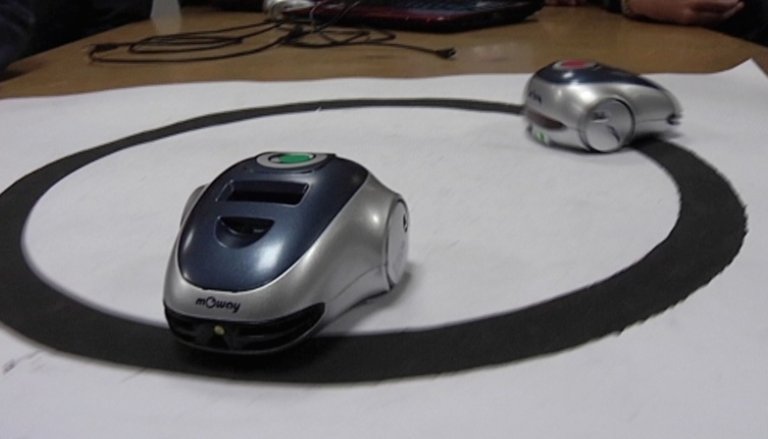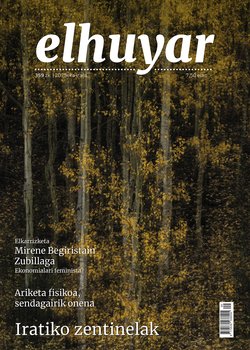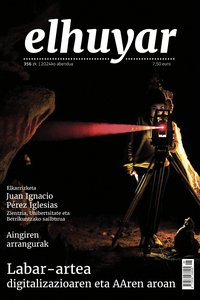Minirobots in the classroom
It's called Moway and it's a minirobot. It has been developed by a company in Bizkaia and is designed so that both children and young people can learn to program. It also has its own programming language for controlling sensors and receiving commands. By arranging a series of blocks or boxes in a diagram, the minirobot does what the student wants. For example, turn on the lights in the tunnels or make a circuit following the black line.

Technology course at the University of Zamudio. Saws and screwdrivers on the walls, on the shelves, material for crafts. But today they have to work with robots, they have to learn how to program robots.
The student is: We have programmed Mowaya to turn to stop when a black line is detected and to do the same again when another black line is detected.And then if we put him in, he's under arrest.
They have their second day working with the robot, but they are already able to give orders to it and the machine understands and obeys the orders. This is because the students and the robot speak the same language.
The student is: This is the beginning, this tells you to move, this is to stop when you find the black line, turn around and go back to the beginning.
This sequence of orders is a program. The creators of both this programming language and the robot itself are not distant: This is the headquarters of the company Minirobots and is located in Erandio.
ELENA MERINO; minirobots: We had an idea to use it in education, based on what we had experienced during our studies. It has always seemed to us that there is a lack of tools to touch technology up close.
The result has its own name: Moway is a mouse-sized robot used on computers.
IÑAKI LETURIA; elhuyar: We need to show the Minorobot's guts now, what's inside the Moway.
ELENA MERINO; minirobots: These are the motors that move the robot, here the microphone
IÑAKI LETURIA; elhuyar: That little one?
ELENA MERINO; minirobots: Yeah, that's right. This is a lithium battery and these are obstacle detection sensors. Line sensors underneath. It also has light sensors, temperature sensors, three-axis accelerometer
Through this port you can also attach other devices, such as a wifi module that gives you the ability to interact with other minirobots liokena.edo, a camera that gives you artificial vision.
The Biscayan company for the control of all these sensors has developed a graphic language based on flowcharts. The use of this language does not require prior computer knowledge. In place of incomprehensible commands and long programming lines, a series of simple modules or blocks are used.
The student is: For example, to go straight, to the left or to the right... these are the sensors to detect obstacles, follow lines, sound...
One of the simplest examples: robots 20 cm. turn on the lights when you move forward and stop. This can be done by first moving the movement module to the work área. It is possible to determine the displacement by changing the parameters of the module: speed, amount, direction. And the same with the light module. Then, the blocks or modules are linked together so that the actions take place in a given order and finally the program is sent to the robot.
ELENA MERINO; minirobots: And we'll record it. What we write is sent to the robot in this way. It’s something you can do in the first lesson, it’s simple, and the robot will respond by moving it.
ASIER FERNANDEZ; Vizcaya College: The truth is that in the first class when I show them that it moves with the sound sensor or if we activate it in the light sensor and we remove the light that will move or stop, at first it is something like magic for them, but then when they start working they understand everything and also understand the reasons and that is important.
The student is: We have programmed it like the other group to follow the line but here in the tunnel, the light will turn on because the sensors have detected less light and as there is more outside they will turn off.
A new version of the robot, based on free arduino hardware, has now been released. but the creators say that the robot is not a toy, it is a means of education. A tool that promotes creativity, initiative, logical thinking and teamwork. Programming is the way.
ELENA MERINO; minirobots:Learning to program with this system is like learning another language, like learning to speak or write. For what reason? Because you don’t need to know anything beforehand, whether you’re a linguist or a writer to learn to speak or write. You don't have to be a programmer here. The learning process is equivalent to learning to play a musical instrument or to play a sport. Learning to program leads us from consuming technology to creating technology on our own.
The student is: The sound will move when it is present and when it is not, it will not move, it will remain inactive.
In this case they have also defined the settings of each sound module, in three levels: as the noise increases, the robot will move faster and faster.
The student is: And if we don't talk, he'll just stand there and go back to his place here and rethink what he has to do.
ASIER FERNANDEZ; Vizcaya College: Let's make a noise that moves faster when there's a lot of noise to see, okay?
In the end, students have to guess what happens between the start and end modules, decide the course of the diagram. This encourages creativity and teamwork. Knowing the capabilities and resources that the robot has, they have to shake their imagination to respond to different situations or solve problems.
ASIER FERNANDEZ; Vizcaya College: For example, in sumo tournaments each robot has its own strategy, they know they can’t get off the black line, they have to go to it when they detect an obstacle, but there are also different strategies to do it, so there are several things to think about to get the end result right there.
Moway understands several languages. The flowcharts have been designed for children from the age of 9, but in addition, the minirobot is also able to use the scratch language designed by MIT, the Massachusetts Institute of Technology. And it is also useful in vocational training and early engineering courses to start learning advanced Moway programming languages. The minirobot covers almost the entire academic life of the student, from high school to university.
ELENA MERINO; minirobots: It is a way for students to organize ideas, they will learn to create things from scratch: to make something incapable of doing anything, such as the robot, fulfill the prescribed actions.
The student is: We've programmed the Moways to write the EITB.
Buletina
Bidali zure helbide elektronikoa eta jaso asteroko buletina zure sarrera-ontzian










